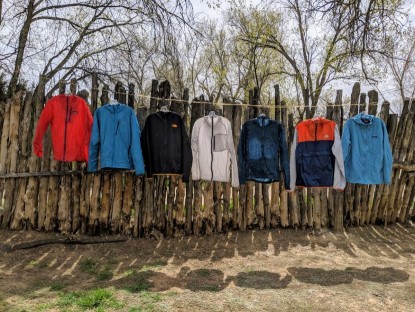We prefer the Patagonia Houdini if you want the ultimate lightweight wind jacket. It weighs a little less, compresses much smaller, and the material did not stick to our skin as much when we sweat.
Alternately, the Squamish Hoody is our highest scoring wind shirt. It kept out the elements better, did not stick to the skin as much when sweating, and can double as an ultralight winter jacket.Marmot Trail Wind Hoody Review
Our Verdict
Our Analysis and Test Results
Hands-On Review
Likes
The armpit and neck vents do a decent job of ventilating and add to the range of motion. For its weight, the material is very burly. It held up to serious abuse while climbing Tahoe granite. It scored great for burliness to weight ratio. We like the big generous chest pocket. It holds an iPhone easily whereas with the Houdini was a stretch to get it in. Because the chest pocket is lined with mesh, it allows some air in for ventilation. Marmot says this weighs 5.0 oz. but on our scale, it came in at 4.8 oz. (size Medium). This makes it incredibly light: only the Houdini and Cirrus are lighter and not by much (less than an ounce). By comparison, it's about the same weight as a cotton t-shirt. It very easily packs into its own pocket and then can clip on the side of a climbing harness or backpack with a keeper sling.
Marmot uses reflective details more than most other jackets to make this jacket a little more visible to cars when running and biking.
Dislikes
The same armpit and neck vents that add breathability also mean the jacket does not block the wind in super high winds (35+ mph). So you can't really seal off the elements at a certain point. It seems it would be better to have neck and armpit vents made of a stretch breathable material that does not have big holes. Marmot uses a mesh fabric reminiscent of a jogging short liner. To be honest, we probably would rather there be no venting material at all in the pits and neck. One of the main reason to buy a wind jacket is protection from high winds and light rain.
Also, while the main material is pretty water resistant, the mesh neck vent lets in moisture, especially if you are bike riding with your head down. More importantly, the main material sticks a little more to bare skin than that of the Houdini or Squamish. This means that when riding a bike the material stuck to our skin rather than giving a little space for air in to clean out the moisture.
The hood tightening mechanism is not our favorite. The first time we used it, we released the drawstring and got hit in the face. Once we were used it, it was better but it does not loosen easily and takes some fussing with.
Best Application
We really like this jacket for climbing. It has a burlier fabric than the Patagonia Houdini and has great range of motion with the arms. It also works great for hiking, biking, and general outdoor use. We would not recommend it for light rain because of the big mesh.
Sizing
The sizing threw us off. Our main Gear Editor is 5' 10" 155 lb. and fits in a size Medium in the Marmot Driclime Windshirt but the Medium Trail Wind was too big and we had to switch to a Small.




